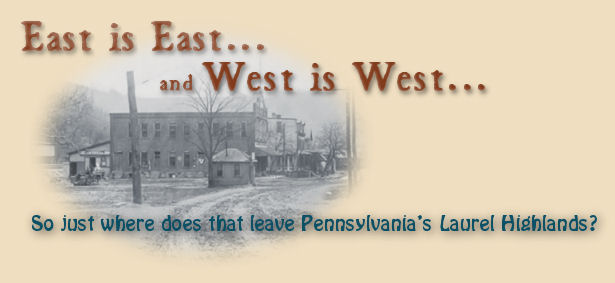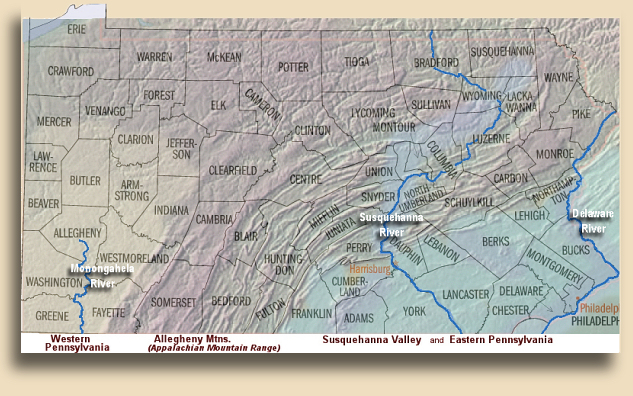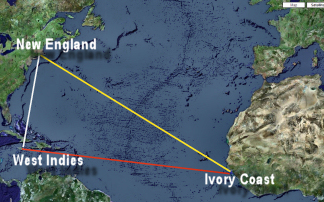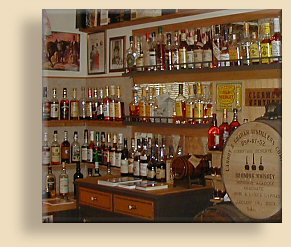American
Whiskey
Distilleries of
Pennsylvania's Laurel Highlands
 |
IN MARCH OF 1946, Winston Churchill was
visiting Westminster College in Fulton, Missouri. The occasion was his
acceptance of an honorary degree, and he used that![]() opportunity to speak about what he perceived as happening in Europe with the
close of the second World War. It was in that speech that Mr. Churchill famously warned the world that, from
“… Stettin in the Baltic to Trieste in the Adriatic an iron curtain has
descended across the Continent.”
opportunity to speak about what he perceived as happening in Europe with the
close of the second World War. It was in that speech that Mr. Churchill famously warned the world that, from
“… Stettin in the Baltic to Trieste in the Adriatic an iron curtain has
descended across the Continent.”
He meant, of course, the European Continent. But
there is such a curtain dividing the North American Continent as well. Only,
this one is made of rock, covered with dirt and forests. It is a very tall
curtain, over half a mile high in some places, and very wide. It does not have
barbed wire and military troops to prevent or control crossing it; it is guarded
by gravity, a far more formidable opponent. It’s name is the Appalachian
Mountain Range, and it extends, virtually unbroken, over 1,600 miles from the
St. Lawrence River of Canada southwest-ward to Georgia and Alabama in the United
States. Even today there are few major highways that cross this wall in an
East-West direction, and even fewer that do so without spending many diverted
miles traveling North-South in the process. In the 17th and early 18th centuries
there were even fewer. Although the Great Conestoga Road between Philadelphia
and Lancaster (still on the eastern side of the mountains) was opened as early
as 1741, it would be another seventeen years before a thoroughfare to Pittsburgh
was completed.

The other major east-west route, the Cumberland road, would connect Baltimore, by way of Maryland’s western outpost Cumberland, to the Ohio River at Wheeling, in western Virginia. But that wouldn’t happen until 1818.
The commercial whiskey industry in western
Pennsylvania had never been the target of the Federal authority-enforcement
action known as the Whiskey Rebellion. In fact, it’s probably safe to say that
the commercial distilleries (whose taxes and licensing were proportionate to
their capacity and who simply passed those costs on to their customers) could
not have been as successful had they needed to compete with hundreds of
independent distillers who were not being taxed. Their product, known as
Monongahela Rye, was unique and distinctive to their region and very different
from the rather harsh, clear spirit which was available east of the Alleghenies.
What it had more in common with was the aged, red-brown, New England rum so
beloved by the well-to-do tavern patrons and social leaders all up and down the
Atlantic coast. Many of the qualities for which Monongahela was appreciated
were the result of its long and arduous journey to market, whether by mule team
across those awful mountains or by flatboat down the Ohio and Mississippi
rivers, and then by ship from New Orleans. And the days and weeks of constant
rocking and jostling were often interspersed with long delays in storage
warehouses, waiting until seasonably impassable river sections or trails
cleared. These conditions were remarkably similar to those endured by New
England rum. Rum made in New England from molasses purchased in the West Indies
was shipped to the West African slave markets and exchanged for fresh slaves,
which were then sold to the West Indies sugar plantations in exchange for
molasses. The repeating cycle became known as the Triangle Trade.
 The
barrels of rum that were loaded aboard the ships in Rhode Island were the
property of the slave-agent, and were intended to be used as barter for
purchasing slaves. The number of slaves to be purchased was finite, there being
only so many that the ship could hold. A good agent would be able to fill the
ship for much less than all the rum he had available, and whatever wasn’t needed
would be his to sell for cash when the ship returned home. In the meantime, it
would have spent months sloshing around on a rocking ship, mostly in intense
tropical heat, followed by possibly a chilling few weeks on its way to New
England and perhaps further storage there. So, when New England rum was ordered
in a tavern, what was expected was a spirit that had a deep copper-brown color,
with the rich flavors acquired from all that barrel contact.
The
barrels of rum that were loaded aboard the ships in Rhode Island were the
property of the slave-agent, and were intended to be used as barter for
purchasing slaves. The number of slaves to be purchased was finite, there being
only so many that the ship could hold. A good agent would be able to fill the
ship for much less than all the rum he had available, and whatever wasn’t needed
would be his to sell for cash when the ship returned home. In the meantime, it
would have spent months sloshing around on a rocking ship, mostly in intense
tropical heat, followed by possibly a chilling few weeks on its way to New
England and perhaps further storage there. So, when New England rum was ordered
in a tavern, what was expected was a spirit that had a deep copper-brown color,
with the rich flavors acquired from all that barrel contact.
Around 1807 the notorious Triangle Trade came to a sudden halt (officially, at least). And although traces of the trade continued for much longer, New England rum, which was never financially feasible except for being subsidized as pre-paid “leftovers” of the slave trade, disappeared as an American consumable. Monongahela Rye whiskey, however, filled the need quite nicely, and western Pennsylvania had a virtual monopoly on its production.
Not for long, of course. The same qualities that resulted from West Pennsylvania’s remoteness could be achieved by alternate means, some more legitimate than others. For example, barrels of whiskey could be warehouse-stored intentionally for long periods. In fact, with the advent of the steamboat and the railroad reducing the travel time from months to days, that would become necessary. Today “aging” is the prescribed way of maturing whiskey. And that method was available to wholesalers no matter which side of the mountains they were on. Notice this listing in the Lebanon (Pennsylvania) County Atlas for 1875:
|
|
|
Other methods of maturing and mellowing liquor were available as well, including adulteration with coloring and flavoring. Rye whiskey, red rye whiskey, was by far the dominant American spirit through the second half of the 19th century, especially in eastern Pennsylvania and in Maryland. Dozens of brands of “Pure Rye” whiskey competed with one another, many of them renowned for their excellence and high quality. The passage of national prohibition in 1919 is often given as the reason for their demise, but the truth is that most of those brands – even the most highly-respected names – vanished immediately after the passage of the Pure Food and Drug Act in 1906.
The commercial distilleries of the west – Overholt, Thompson, Large, Dillinger, Gibson, Guckenheimer – were not much affected by all that. The Appalachians are not just tall; they’re wide as well – up to 200 miles across at some points. And that provided a sort of cultural insulation between West and East. As for settlers within that mountainous zone in between, well, they made whiskey just like everywhere else, selling mostly locally.
At least they did until civilization caught up with them…
Click Here to visit the remains of some of these legendary distilleries...



